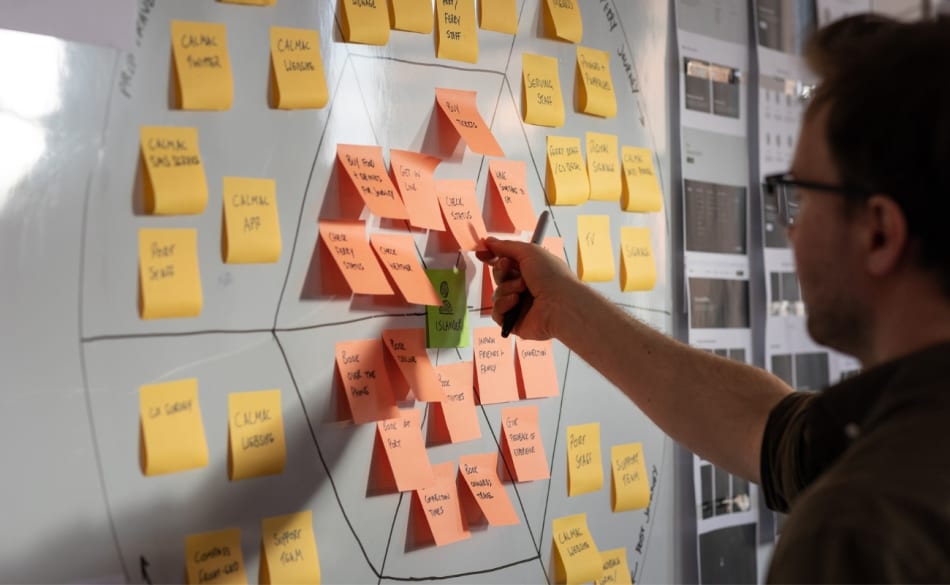




Diverse People, Diverse Perspectives
Waracle is an inclusive, inspiring & developmental home to the most talented and diverse people in our industry. The perspectives offered in our insights represent the views and opinions of the individual authors and not necessarily an official position of Waracle.
In all natural cycles, there is an ebb and flow. Things inevitably, come in and go out of favour. In a recent article for MIT Technology Review, Rebecca Ackermann asked the somewhat provocative question ‘where did it all go wrong for design thinking?’.
In this week’s blog, our team asks the question “Has Design Thinking reached its Apex?” and discuss whether Design Thinking has merely shedded the fast-follower fashionistas to reveal a faithful followership ready to democratise design?
Let’s find out!
A potted history of design thinking
The DNA of Design Thinking started as far back as the 1970s, but it was only really in the early 1990s that it became mainstream, with IDEO being credited for inventing the term and its practices.
Fast forward to today and the phrase Design Thinking can be found everywhere… from banks to creative agencies, pharmaceutical companies to software development houses.
Like agile took software development by storm, many modern design practices, whether in-house or agency-side have migrated towards a human-centred design methodology to some degree to build and deliver products & services that fulfil and delight their customers.
Its practices have widely been adopted by the UX communities throughout the world, and because of design thinking’s popularity, there are books, online courses and even university degrees on the subject.
A growing chorus of detractors?
Like any framework or methodology, there will be people who adopt, embrace and thrive by applying them… and conversely, there will always be people that find they miss the mark and don’t give them what they want.
In the article that we mentioned from MIT technology review, the author outlines examples where she believes that Design Thinking has missed the mark in delivering successful outcomes for the people it purported to serve.
This sort of experience is nothing new in the complex world of incepting and delivering digital products, services and solutions that have an impactful experience on the end user. The internet is littered with articles and posts recounting why modern frameworks, like Agile, Lean, Lean UX, Waterfall, Scrum and more, failed to deliver the desired effect, outcome or impact.
There are many factors that contribute towards the particular approach either succeeding or failing. And in many cases, these frameworks and methodologies take the brunt of the blame. However, in reality, the issues tend to occur in the application of these frameworks and methodologies, not in the thinking itself.
You didn’t hit the car in front because your car drove itself. You hit the car because you were not driving correctly. The same analogy can be applied when design thinking hasn’t delivered the outcomes you expected.

What actually is design thinking?
Design Thinking is a non-linear, iterative process that places empathy at its core.
You are designing with the end user in mind, which in many ways makes perfect sense and shouldn’t be in any way revolutionary. Humans, by our very nature, are designers. Everything you interact with in your day-to-day life has been designed by someone to serve a purpose, and if it doesn’t serve a purpose, it will not last long in your life… From the bed you sleep in, the cup you drink your coffee from, the shirt on your back or the smartphone in your hand, they have all been designed to live in harmony with you. If you have to think about their application, then it’s not serving its purpose.
The practical application of Design Thinking follows a defined number of steps, and while the terminology of the steps may vary from person to organisation to community, they broadly follow the below categorisation:
Discover
Empathise – Conduct research to understand better the job/s the end user is looking to achieve.
Define
Analyse – Interrogation of the data to understand the pains and gains, using techniques such as:
- Affinity grouping to spot patterns
- Jobs to be Done, to find areas of opportunity that are of high importance but underserved
- Brainstorming through “How Might We” statements to generate ideas
Develop
Ideation – Initial concept architecture of the best ideas and concepts
Refinement – Further refinement of the best ideas for development
- Importance and Viability/Feasibility matrix
- Research and data mapping (the concept solves the actual problem)
Deliver
Prototype – Creation of the preferred concept candidate into prototype format
- Lo-fi, paper format
- Hi-fidelity prototype, clickable UI screens
- Work Prototype, minimal code with a stub or mock data to mimic a real-world response
Testing of the concept with the desired cohort.
- Moderated
- Unmoderated testing
Iteration – Analysis of the testing data and adaptation of the concept and re-test
Hypothesis validation – Confirmation that your solution solves the problem.
…
There is a reason that we stopped at hypothesis validation.
We have seen many situations, where even though process and methodology was adhered to, the end solution or product missed the mark. In our experience, that is directly due to the ‘design thinking’ only being applied during Discovery in isolation and not being continued through into the Construction phase.
Our team have seen countless examples of how agencies brought in to help solve the problem, departed before the ground was broken, so did not invest in the overall desire for change.
The Construction phase is the genesis of the solution that will ultimately solve the problem, and in our mind, if you exit at this stage, then your work is only half done.
Making design thinking work for your organisation means adopting it into your product-mode operation as an iterative, value-exploration activity rather than a slightly better way of defining your fixed product specification!

What does the future hold?
As we mentioned at the beginning, methodologies and the way we approach things change.. and fall in and out of favour. Design thinking seems to be entering a critical moment, where its adopters are discussing its validity and its potential going forward.
As our world changes expediently at the macro level, we take a brief look at where Design Thinking could still develop its place & position in terms of technology, the environment and commerce:
Environment
There is growing recognition of the need to address complex societal challenges with particular emphasis on sustainability & environmental impact. Design thinking can play a key role in this effort by helping designers to focus on the end users’ desire to limit their carbon footprint and create products, services, and systems that are more eco-friendly and resource-efficient. In many ways, you could say it is an environmentally-centred design, and it needs to be. As we move to a carbon-neutral society, we must start to think about our impact and design thinking can certainly help us achieve this.
Technology
As artificial intelligence (AI) and automation become increasingly prevalent in various industries and sectors, there is a risk that technology development may prioritise efficiency and optimisation at the expense of human needs and desires. For example, an AI system that is optimised to maximise profits for a business may make decisions that harm the interests of customers or employees. Human-centred design thinking can play a crucial role in addressing this challenge by placing people’s needs and desires at the centre of the technology development process.
Commerce
As businesses increasingly prioritise innovation, we can expect to see design thinking becoming even more essential in the coming years. As our demand for value from the products and services we interact with increases and our tolerance for inefficiency diminishes, organisations will need to invest in training their employees in the methodology, recognising its value in driving innovation and creating products and services that meet the needs of users, which in turn will help them stay competitive and will ultimately be the difference between commercial success and failure.

Does design thinking deliver on its promise?
We are huge advocates of the value of Design thinking. By placing empathy front and centre in the products and services we build, we generate tangible value from helping the end user perform the job they are trying to achieve, therefore elevating the pain to focus on the gain and satisfaction.
The double-diamond approach is an amazing blueprint, but that is all it is.
You cannot view it merely in one dimension, and if you do, your application of it will probably fail. Each section, from the research to the ideation to the conclusion needs to be well thought out, planned and delivered. It needs to be correctly resourced and, more importantly, supported & accepted that the evidence will define the trajectory.
Listen to what the research is telling you and build your product around it… and focus your iterative construction on what your end user wants, not what you think they want.
At Waracle, we are faithful followers of this methodology due to the success it can bring when implemented correctly. A bad worker blames their tools and we pride ourselves on being great workers, who use the best tools!
If you want to hear how we can apply Design thinking to your business, then we would love to hear from you.
Authors
Principal Product Consultant
Related

Article • 08 May 2025
Embracing the AI First Future

Article • 26 February 2025
Turning data into your competitive advantage

Article • 31 January 2025
Cultivate your ‘data as an asset’ agenda

Article • 25 September 2024
Can you build emotional loyalty through digital experiences?

Article • 30 July 2024
LLMs in Healthcare Diagnostics

